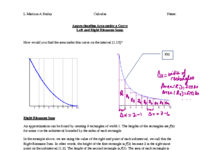Intro to Series: Improper Integral Riemann Sums
- Author:
- L. Marizza A. Bailey
Activity Directions
Infinite Riemann Sums
Background knowledge: A Riemann Sum is an approximation of the area of the region between the graph of a function and the x-axis by the sum of areas of rectangles, usually over a finite interval [a, b]. The interval [a, b] is partitioned into subintervals (partition means to divide into parts with no common overlap but which all together make up the whole). The subintervals become the "width" of the rectangles, and the "height" of the rectangle is a point on the graph whose x-value is in the corresponding subinterval. We will be extending this idea over an infinite interval. The rectangles above are all of width 1. The height of each rectangle is given by finding the point on the graph whose x-value is the left most point in the corresponding subinterval (The Left Riemann Sum), or the right most point in the corresponding subinterval (The Right Riemann Sum). We have just finished the unit on improper integrals, which can represent the areas of regions between the graph of a function and the x-axis over an infinite interval, like the one above. We learned that integrals on intervals of infinite length either diverge, are equal to infinity, or converge, are equal to a real number. Therefore, ithe regions between a graph and the x-axis over infinite intervals have finite area when the corresponding integral converges. For example, we learned that: 1. diverges so the area between the graph of and the x-axis on [1,) has infinite area. 2. converges so the area between the graph of and the x-axis on the same interval has area = 1. 3. converges 4. converges Today you are going to investigate how these integrals are related to the infinite sums: A.
B. C. and more.... The graph below is the graph of . You can change p by using the sliders. The integral of f over the interval [1, c ] is shaded in orange. You can change c by using the slider labeled D. ( c = 100 times D) Preparation for Activity: The Left Riemann Sum of f over the interval [1, c ] is shaded in purple.- What is the area of the first rectangle?
- What is the area of the second rectangle?
- What is the area of the nth rectangle?
- What is the sum of the areas of the visible rectangles?
- What is the area of the first rectangle?
- What is the area of the second rectangle?
- What is the area of the nth rectangle?
- What is the sum of the areas of the visible rectangles?
A review of Left and Right Riemann Sums
Sum(A)
To which integral is sum (A) related? Is it the Left Riemann Sum or Right Riemann Sum?
